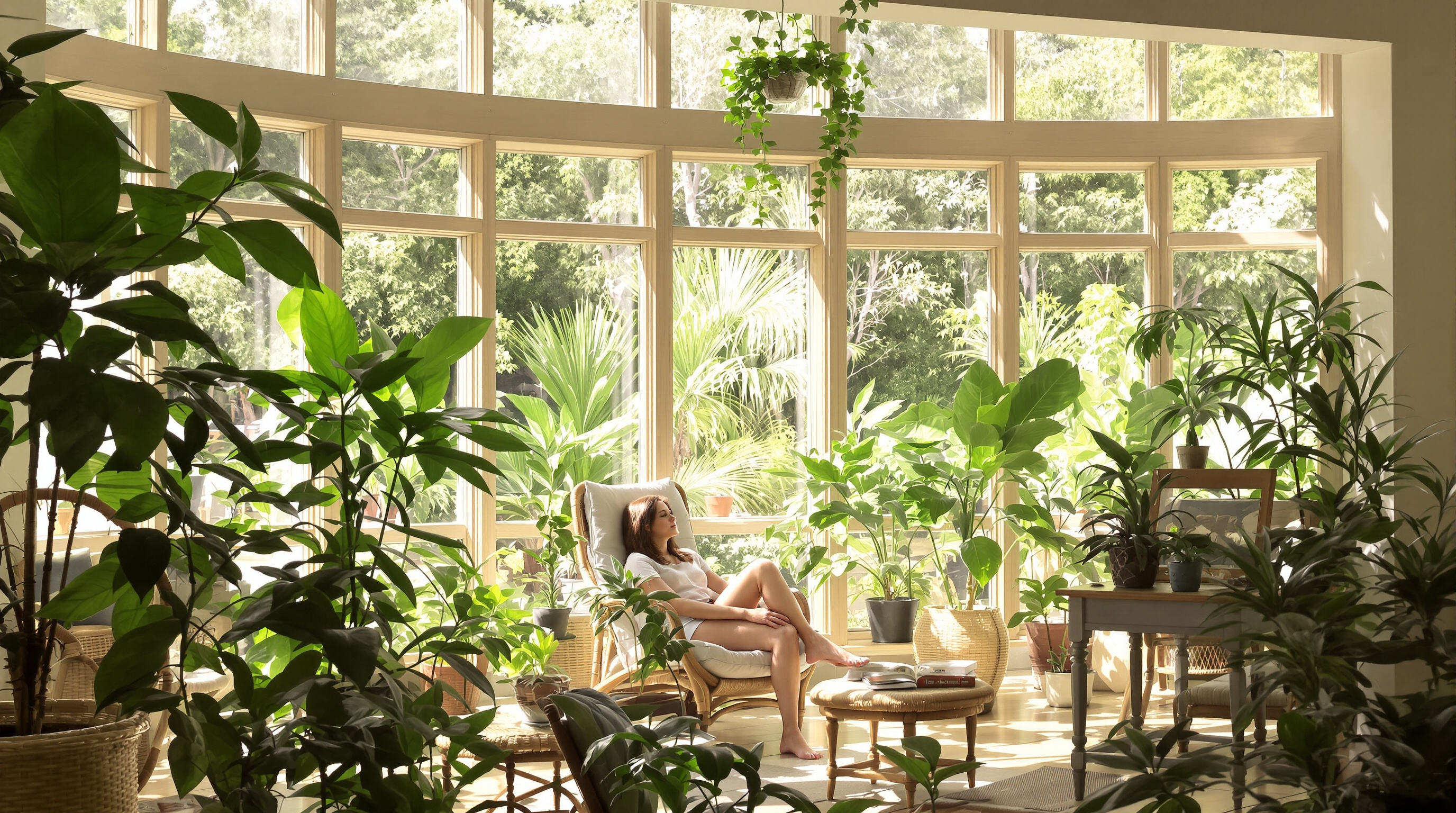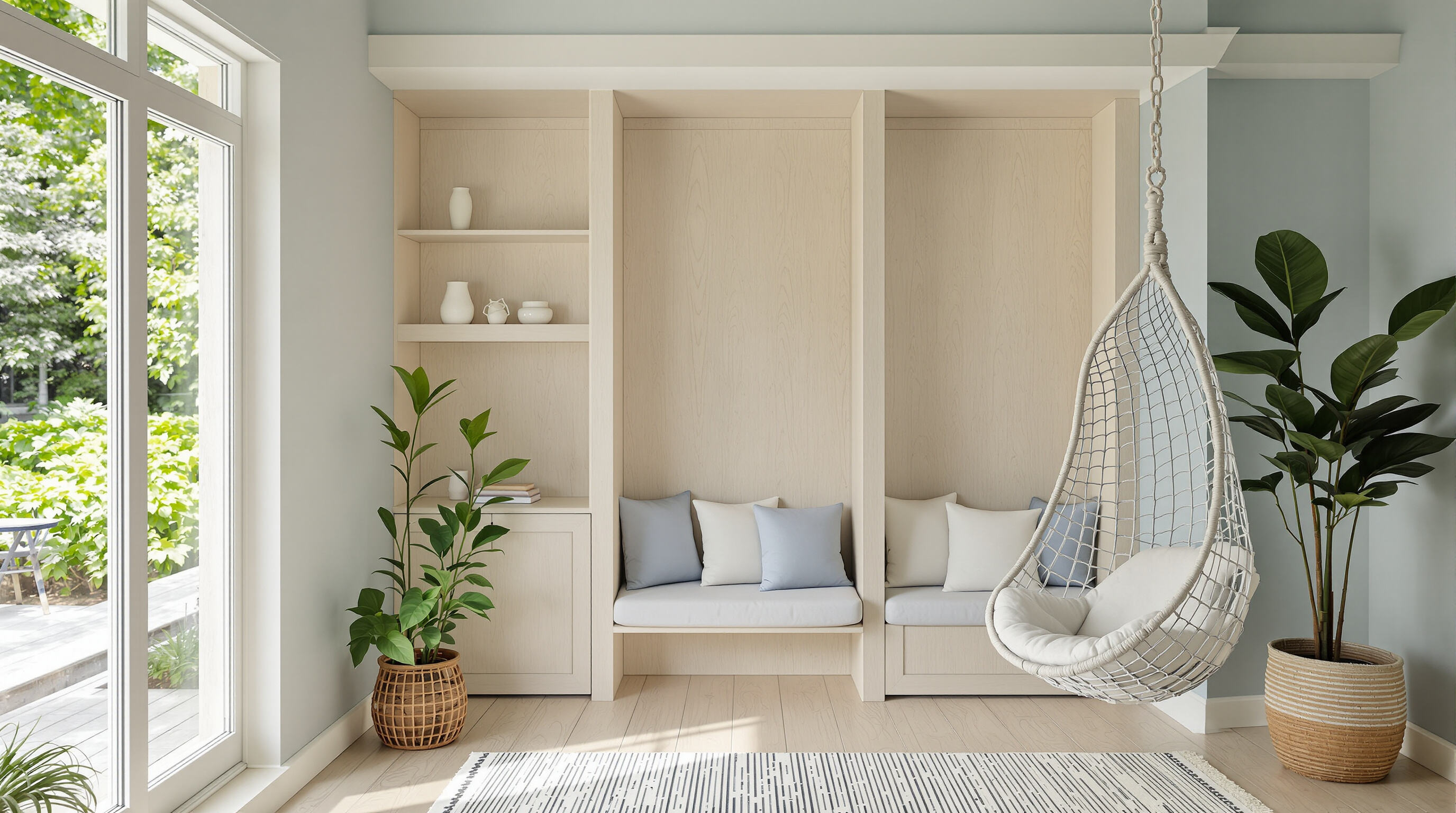The Wellness Benefits of Natural Light in Sunrooms

Increased Exposure to Natural Light and Vitamin D Production
Getting more sunlight is one of the main benefits of having a sunroom. The extra daylight helps our bodies make vitamin D, which plays a big role in keeping bones strong and supporting the immune system. According to research from the National Institutes of Health published last year, spending about half an hour each day in a sunroom could cover around half of what the body needs for this important nutrient. That's pretty significant considering how many people these days spend most of their time indoors. Sunrooms work well because they're basically made of glass on all sides. This setup lets in plenty of those helpful UVB rays without exposing anyone to direct sunlight for too long, making it safer than just sitting outside under the sun all day.
Scientific Evidence Linking Sunlight to Enhanced Mood and Mental Health
Getting some natural light actually helps our bodies produce more serotonin, which is basically nature's happy chemical linked to better moods and feeling more emotionally balanced overall. A study back in 2022 looked at 15 different experiments and discovered something interesting: people who got about 20 minutes of sunshine each day had around 34% better mental health ratings compared to folks stuck in dimly lit spaces according to the Journal of Environmental Psychology. And it gets even better for those with sunrooms. These spaces can really help regulate our body clocks too. Research indicates that folks who spend mornings in their sunrooms experience roughly 22% better sleep quality. Makes sense when we think about how our bodies naturally respond to light throughout the day.
Stress and Anxiety Alleviation in Sunroom Environments
Studies show that spending time in sunrooms with lots of natural light and nice views outside can actually bring down cortisol levels by around 28% after just three weeks of regular visits according to research published in the Annals of Behavioral Medicine back in 2023. These spaces become real stress relievers when they have plants growing nearby and clear lines of sight to nature beyond the glass walls. The body responds positively to this kind of setting, showing lower signs of physical stress over time. What's more, many modern sunroom designs now incorporate special acoustic features that help block out city sounds, making them even quieter sanctuaries where people can truly relax without all the usual background noise from streets and traffic.
Case Study: Sunroom Use in Seasonal Affective Disorder (SAD) Therapy
Research from the University of Michigan back in 2023 showed something interesting about seasonal affective disorder treatment when they added sunrooms to the mix. About 72 percent of people who participated reported fewer depressive symptoms throughout the winter season. The study looked at patients who spent around 45 minutes each day in these specially designed spaces with full spectrum lighting. What stood out was how much quicker they recovered compared to folks relying just on those standard artificial light boxes. We're talking about a recovery time that was roughly 40% faster actually. This suggests there might be some real value in properly constructed sunrooms as part of treatment plans for various mood disorders, though obviously more research would still be needed to confirm these findings across different populations.
Designing a Sunroom for Relaxation and Mindfulness

Creating a Tranquil Atmosphere with Natural Materials and Soft Furnishings
The calm atmosphere of a sunroom starts with what goes into building it. Wood frames, stones here and there, plus those woven rattan chairs bring in nature's feel right inside. Throw in some linen drapes and comfy cushions for sitting around, and suddenly the space feels inviting. Studies indicate that rooms filled with natural stuff can actually cut down stress hormones by about 18 percent when compared to all plastic looking places according to Environmental Psychology Review from last year. Adding some greenery works wonders too. Plants such as peace lilies or snake plants not only look great but they clean the air while doing so. These elements together create something special - almost like being outside without stepping foot outside at all.
Designing a Sunroom for Meditation and Mindfulness Practices
Good meditation spaces tend to have clear lines of sight and not too much stuff lying around. Many people find that having their own little corner works best, maybe with some floor cushions or a hanging chair facing out towards plants or nature. The colors matter too. Studies suggest that rooms painted in soft greens and blues can actually make folks stay in meditation longer, something like 23% extra time according to some recent research on how buildings affect our brains. Walls and ceilings made from materials that soak up sound help cut down on those annoying background noises from the house. And don't forget about music or guidance during sessions either. Most modern setups include hidden speakers so practitioners can play calming tracks without any hassle.
Strategy: Optimizing Light and Acoustics for Maximum Relaxation
| Factor | Ideal Implementation | Benefit |
|---|---|---|
| Daylight Modulation | Layered window treatments | Balance brightness without glare |
| Temperature Control | Insulated glass + ceiling fans | Maintain 68–72°F comfort zone |
| Sound Management | Acoustic panels + cork flooring | Reduce echo by 40% |
Smart glass technology automatically adjusts tint, maintaining optimal ambient light levels that help stabilize heart rate during relaxation.
Controversy Analysis: Overexposure to Sunlight vs. Controlled Light Exposure
Sunrooms definitely have their perks for wellbeing, but there's no getting around the fact that too much time in direct sunlight can be bad news for our skin. According to research published by Johns Hopkins last year, installing special low-E glass or applying those UV blocking window films stops almost all the dangerous rays while still letting enough through for our bodies to make vitamin D naturally. For folks who want control over how much light comes in, retractable shades work great or adjustable louvers are another option. These let people adjust the brightness depending on what they need at different times of day, so we get the best of both worlds really good lighting for our internal clocks without risking sun damage.
Maximizing Home Value with a Functional Sunroom Addition
Year-Round Use and Comfort as a Selling Point in Real Estate
Sunrooms designed for year-round use are increasingly attractive in real estate. Features like insulated glass, radiant floor heating, and energy-efficient ventilation ensure comfort across seasons. These upgrades transform sunrooms from seasonal luxuries into functional living spaces, appealing to 73% of homebuyers seeking adaptable environments (National Association of Home Builders, 2023).
Data: Homes with Sunrooms See 5–12% Increase in Market Value
Adding a sunroom to a house can actually increase its market value anywhere from 5% to maybe even 12%, which beats most other home improvement projects when it comes to getting money back on what was spent. Most appraisers count these spaces as part of the living area since they're usually kept at comfortable temperatures year round through heating and cooling systems. Take for example someone who spends around $45k on building a 200 sq ft sunroom. That could potentially bump their home's worth by as much as $63k. Not bad considering how nice those extra few thousand dollars feel when sitting outside with coffee or watching plants grow in the springtime.
Blending Indoor and Outdoor Living Areas to Attract Modern Buyers
Modern homebuyers really like houses where inside and outside feel connected. Think about those sunrooms with sliding glass walls, stone flooring that looks great but also stands up to weather, and those nature-inspired touches throughout the space. These kinds of designs make moving from indoors to outdoors feel completely natural. According to recent research from the American Institute of Architects (2022), around two thirds of potential buyers actually put a lot of weight on finding homes that look good while still giving easy access to outside spaces. Properties with these kinds of sunroom additions tend to stand out in the marketplace as something special for discerning buyers looking for quality living environments.
Versatile Sunroom Uses: From Hobbies to Home Offices
Sunrooms for Dining, Reading, and Indoor Gardening
Sunrooms create great spaces for things people enjoy doing when they need lots of daylight. Many folks use them as dining spots where sunlight streams in, making even rainy day meals feel somehow linked to the outside world. The lighting is so good for growing plants too. People can grow all sorts of stuff here - fresh herbs on windowsills, tough little cacti, maybe even a tiny lemon tree if space allows. Book lovers especially appreciate these rooms as reading nooks. Soft chairs sit in corners away from harsh glare. Research published in the Indoor Environment Journal back in 2023 found that reading under natural light actually cuts down eye fatigue by around 34%. Makes sense really, our eyes just work better with real sunlight.
Versatile Use for Hobbies and Personal Activities
Sunrooms are pretty versatile when it comes to creative stuff and just having fun. Painters love how they get good light throughout the day for their artwork, and some folks actually find that music sounds better in those glass enclosed areas too. A lot of people who own these rooms end up doing all sorts of things there regularly - like 6 out of 10 owners report using their sunroom for multiple hobbies each week. Some stretch and do yoga, others build models or write in journals. Basically, these spaces become special corners where individuals can express themselves without worrying about anyone else around.
Trend: Home Offices and Fitness Spaces in Sunrooms Post-Pandemic
More remote workers these days are turning their sunrooms into office spaces that overlook gardens, and many say they get about 28 percent more done than when working inside regular offices according to some recent studies from Remote Work Insights in 2024. The same kind of shift is happening with fitness too after all those pandemic years at home. People want to set up their gyms right there in the sunroom where sunlight actually makes them feel more motivated to exercise. Smart homeowners now look for windows that save on energy bills plus adjustable blinds so they stay comfortable whether joining Zoom meetings or going through tough workout sessions. It's pretty cool how these spaces combine health benefits with practical everyday needs without feeling forced or artificial somehow.
FAQ Section
What are the health benefits of spending time in a sunroom?
Spending time in a sunroom increases exposure to natural light, which helps in vitamin D production, boosts mood by enhancing serotonin levels, alleviates stress and anxiety, and offers potential therapeutic benefits for seasonal affective disorder.
How can sunrooms impact home value?
Sunrooms can increase home market value by 5-12%, particularly when designed for year-round use. They appeal to buyers by blending indoor and outdoor living spaces, adding functional living areas, and potentially providing a high return on investment.
Can a sunroom be used year-round?
Yes, with the right features such as insulated glass, radiant floor heating, and energy-efficient ventilation, sunrooms can be enjoyed throughout the year.
How do sunrooms benefit remote work or home offices?
Sunrooms offer remote workers an inviting office space with natural views, increasing productivity by about 28%. They provide a pleasant environment that fosters concentration and reduces stress.
What precautions should be taken regarding sun exposure in sunrooms?
To avoid overexposure to sunlight, install low-E glass or UV-blocking window films. Additionally, use retractable shades or adjustable louvers to control incoming light and protect against potential sun damage.

